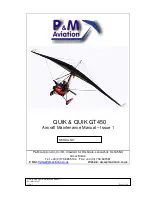
Java
150
Owner`s Manual
The VB. may also be difficult to pull if mud or stones get into the lower casting.
Remove the obstruction.
Other problems are unusual but are most easily cured by following the VB. cord until
you find an obstruction.
The wings are difficult to close when de-rigging the glider
When the tension strop is released it should be pushed towards the keel pocket to feed
some slack into it. This allows the wings to move together more easily. It is possible
for the tension strop to get caught on:
The Kingpost channel,
or with the wings further in, the end of the nose batten.
Release the tension strop and continue to move the wings inboard.
The back of the kingpost gets caught on the sail when rigging
Check the rigging instructions: The kingpost should be raised before the wings are
moved out. When the kingpost is raised the kingpost hole should be held back to
allow the base of the kingpost through the hole in the sail.
A 'pop' is heard on take off
The lower wing wire goes though a small hole in the sail. During the "pre-flight" this
area should be checked. One of the ferrules on the wire can get caught in the sail. If
this happens the ferrule will normally "pop" through the hole on take off. (See above:
this can also make the tension difficult to pull on when rigging.)
The glider has a turn
Check for crash damage then see tuning instructions.
The glider has become more difficult to turn
1. This can be caused by an incorrect but symmetrical batten profile. (Asymmetrical
battens tend to cause turns.) The glider handling does deteriorate significantly if
battens are out of profile. Check the battens (don't forget the nose batten) against the
profile more regularly.
2. This may also be caused by an incorrect trim position (the position of the king
post). The glider might be trimmed too slow "hands off" and be flying in a semi-
stalled condition. See tuning instructions.
The glider is heavy or "strange" in pitch
29






































